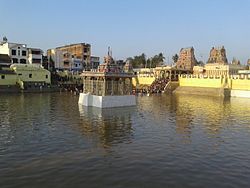Sarangapani Temple
| Sarangapani Temple | |
|---|---|
 | |
| Religion | |
| Affiliation | Hinduism |
| District | Thanjavur |
| Deity | Sarangapani (Vishnu) Komalavalli Thayar |
| Location | |
| Location | Cholas |
| Part of a series on |
| Vaishnavism |
|---|
 |
The Sarangapani Temple is a Hindu temple dedicated to Vishnu, located in Kumbakonam, Tamil Nadu, India.
It is one of the
The temple is one of the
The temple is believed to be of significant antiquity with contributions at different times from
Sarangapani is believed to have appeared for sage Hemarishi. The temple has six daily rituals at various times from 5:30 a.m. to 9 p.m., and twelve yearly festivals on its calendar. The temple chariot festival is the most prominent festival of the temple, celebrated during the Tamil month of Chittirai (March–April). The twin temple chariots are the third-largest in Tamil Nadu, each weighing 300 t (660,000 lb).
Legend
As per Hindu legend, the
History
The Mahasamprokshanam also known as kumbhabhishekam of the temple was held on 13 July 2015. A large number of devotees took part in the Mahasamprokshanam.[8]
The temple is maintained and administered by the Hindu Religious and Charitable Endowments Department of the Government of Tamil Nadu.[9]
Architecture
Sarangapani is the largest Vishnu temple in Kumbakonam and has the tallest temple tower in the town. The temple is enshrined within a huge wall and the complex enshrines all the water bodies of the temple except the Potramarai tank. The
In
Religious significance

Sarangapani temple is considered third in the line of Srirangam and Tirupathi temples.
The temple is counted as one of the temples built on the banks of
Five Vishnu temples are connected with
Worship and festivals

The temple follows
Akshaya Tritiyai - 12 Garuda Sevai Chaitra Brahma Utsavam celebrated during the Tamil month of Chittirai (April - May), Vasantotsavam during Vaikasi (May - June), Pavitrotsavam - Ekadasi Jyeshotsavam during Adi(July - August), Sri Jayanthi - Uriyadi Utsavam during Avani (August - September), Navaratri Utsavam - Saraswathi Puja - Vijayadasami during Purattasi (September - October), Deepavali - Shraddha of Sri Lakshmi Narayanaswami during Aippasi (October - November), Deepa Utsavam - Unjal Utsavam during Karthigai (November - December), Pakal Pattu - Ira Pattu Pongal Sankaramana Utsavam during Margazhi (December - January), Kanu Utsavam - Amavasya - Ratha Saptami during Thai (January - February), Masi Magaham - Float Festival during Masi (February - March) and Brahmmotsavam - Tirukkalyanotsavam during Panguni (March - April) are the festivals celebrated in the temple.[22]
Religious importance
Five Vishnu temples are connected with
As per a temple legend, once a staunch
The temple is called Ubaya Pradhana Kshetram as the mulavar (presiding deity) and utsavar (festive deity) enjoy the same importance. As per legend, Tirumalisai Alvar was singing praise of Aravamudan and he requested him to raise up from his reclining position. Aramudan started raising to gargantuan proportion forcing Thirumalisai Alvar to request him to recline again. The idol stopped midway and the current posture, Uthana Sayi was established. It is believed that the presiding deity asked Nathamuni to compile the four thousand verses of Nalayira Divya Prabandham at this place.[23]
Temple chariot
The twin temple chariots weigh 300 t (660,000 lb) each and has been renovated in 2007. The chariots were not drawn for some years during the preceding period. The chariots are next only in size to the ones in
See also
- Mahamaham
- Mahamaham tank, Kumbakonam
- Hindu temples of Kumbakonam
Notes
- ^ M. S., Ramesh. 108 Vaishnavite Divya Desams: Divya desams in Malai Nadu and Vada Nadu. Tirumalai-Tirupati Devasthanam.
- ^ a b "Pancharanga Kshetrams". Indiantemples.com. Retrieved 20 June 2007.
- ^ a b Ayyar 1991, p. 324
- ^ ISBN 978-93-83440-34-4.
- ^ V., Meena (1974). Temples in South India (1st ed.). Kanniyakumari: Harikumar Arts. p. 25.
- ^ a b c d Gopal, Rupa (5 March 2004). "Immortalised in stone". The Hindu. Archived from the original on 11 July 2004. Retrieved 8 April 2013.
- ^ a b c "Sthala Varalaru". Kumbakonam: Sarangapani Temple Administration. Retrieved 7 April 2013.
- ^ "Mahasamprokshanam of Sarangapani temple done". The Hindu. 15 July 2009. Retrieved 14 July 2015.
- ^ Hindu Religious and Charitable Endowments Act, 1959
- ^ H., Sarkar (1974). The Kampahesvara temple at Thirubuvanam (PDF). Madras: Department of Archaeology, Government of Tamil Nadu. p. 9.
- ^ Ayyar 1991, p. 534
- ^ ISBN 9788120618893.
- ISBN 978-81-7823-542-4.
- ISBN 978-81-7907-053-6.
- ^ T.S., Subramanian (23 September 2010). "How karana sculptures in Big Temple were discovered". The Hindu. Retrieved 8 April 2013.
- ^ Ayyar 1991, p. 327
- ISBN 9781684666041.
- ISBN 978-81-7755-280-5. Retrieved 13 December 2012.
- ISBN 978-0-14-341421-6.
- ^ a b Mahamaham Festival 2004 (in Tamil), Hindu Religious and Charitable Endowments Administration Department, Government of Tamil Nadu, 2004
- ^ a b "Puja Timings". Kumbakonam: Sarangapani Temple Administration. Retrieved 7 April 2013.
- ^ "Festivals". Kumbakonam: Sarangapani Temple Administration. Retrieved 7 April 2013.
- ^ R., Dr. Vijayalakshmy (2001). An introduction to religion and Philosophy - Tévarám and Tivviyappirapantam (1st ed.). Chennai: International Institute of Tamil Studies. pp. 473–4.
- ^ "Immortalised in stone". The Hindu. 2 July 2009. Retrieved 8 April 2013.
- ^ Krishnamachary, Suganthy (29 March 2019). "Marvels in wood". Friday Review. The Hindu. p. 10.
References
- Ayyar, P. V. Jagadisa (1991). South Indian shrines: illustrated. New Delhi: Asian Educational Services. ISBN 81-206-0151-3.
External links
- "Kumbakonam Municipality". Archived from the original on 1 February 2014.








